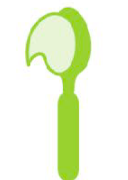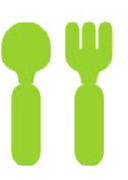Development-based Milestones
The Gerber Nutrition Journey is a unique milestone-based plan with guidance on developmentally appropriate feeding choices. In line with the CDC developmental milestones and the Dietary Guidelines for feeding infants and children, the Gerber Nutrition Journey recommends starting with breastfeeding because breastmilk is the ideal food for babies. Once baby is ready, Gerber can provide guidance on developmentally-appropriate feeding choices.
picture_as_pdfVIEW PDF BROCHURE picture_as_pdfVIEW PDF INFOGRAPHICToddler Development
Gross Motor

- Stands alone
- Walks with and without support
Fine Motor

- Feeds self easily with fingers
- Fine pincer grasp developed
- Begins to use spoon and fork
Oral Motor

- Able to drink from a cup or straw
- Skillful at chewing complex foods
- Bites through a variety of textures
- Coordinated tongue movement
- First year molars begin erupting
Toddler Nutrition
Eating Skills 12-18 months
- Dips spoon in food rather than scooping
- Begins using fork by scooping
- Moves food precisely between the gums or teeth for chewing more complex food
- Sits in a high chair for safety and security at family dinner table
- Bites skillfully through soft foods but may have more difficultly with firm, hard food
- Grasp the cup with both hands and tilts it to mouth with wrist rotation
- Typically uses an up-down movement of the jaw when drinking
- Takes liquids primarily from a sippy cup with valve
- May lose some liquid when drinking from an open cup or straw
- Takes 2 or more swallows in succession and drinks up to 2 ounces or more without stopping

Eating Skills 19-24 months
- Emerging wariness of new foods; needs multiple presentations of a new food (as many as 10-20)
- Can be erratic in variety and volume of intake; monitor intake over the course of a week not a day
- When pressured to eat more, will likely eat less
- Enjoys having same pattern repeated at mealtime; same bib, spoon
- No longer needs the high chair safety and security
- May continue to lose some food and saliva when chewing
- Typically uses an up-down movement of the jaw when drinking
- May open the mouth wider than necessary to bite through the food. Chews easy meats easily and well. Offered more opportunities to drink from a regular open cup, but primary liquid is given with a sippy cup

Feeding Tips 12-18 months
Mealtime is all about learning. Toddlers will get plenty of practice when offering:


Toddlers may be ready for cow’s milk or a nutritious toddler drink.

Toddlers can bite through a variety of textures at this age. If the toddler can grasp a spoon or fork, offer thick, spoon-hugging textures and try soft, bite-sized food the child can spear.

Learning to use utensils is a process that builds fine motor skills, hand-eye coordination, and even hand-to-mouth coordination.

Keep in mind
Using utensils is a complex skill. A toddler will need practice and time to master.
Feeding Tips 19-24 months

Mealtime is a toddler’s time to practice independence. Keep offering both new and favorite foods, and let the toddler decide whether or not and how much to eat.

Continue to let toddlers practice with utensils. Offer more challenging textures for scooping and spearing.

Toddlers at this age thrive on routine and feel secure knowing what to expect. Providing a routine of meals and snacks can help independent toddlers enjoy eating.
Findings from Nestle’s FITS provides much needed information on feeding practices, nutrient shortfalls and opportunities to improve the food patterns of infants, toddlers and preschoolers that may inform your recommendations and provide evidence for the development of the upcoming Birth to 24 Dietary Guidelines for Americans. See highlights and key learnings from the study.

Keep in mind
It can take up to 10 tries with a new food before a toddler decides to give it a go.
Hunger Cues 12-18 months
- Expresses desire for specific foods with words and sounds
- Combines phrases with gestures such as “want that” and pointing
- May appear low in energy, patience, and good cheer or exhibit “crabby” behavior when hungry
I'm hungry!

Expresses desire for food with words, sounds, or gestures
Hunger Cues 19-24 months
- May approach kitchen or dinner table on their own
- Expresses desire for specific foods with words and sounds
- Can lead parent to refrigerator and point to a desired food or drink
I'm hungry!

Expresses desire for food with words, sounds, or gestures

Can lead you to fridge and point to desired food or drink
Fullness Cues 12-18 months
- Shakes head to say “no more” when full
- Bat, push, or drop the serving dish off feeding surface
- Clamp lips shut, stops opening mouth
- Leans back away from offered food and may close eyes
- May stick tongue out when food is offered
I'm full!

Shakes head to say “no more”

Uses words like “all done” and “get down”

Crosses arms and refuses food
Fullness Cues 19-24 months
- Becomes easily distracted
- Hesitates before opening mouth to accept additional food (automatic response)
I'm full!

Becomes easily distracted

Hesitates before opening mouth to accept more food
Products for Toddler
Toddler Foods
Developmentally appropriate textures that meet a growing infants' needs with essential nutrients like iron for brain and cognitive development, B vitamins, vitamin E, C, Zinc and Calcium.











